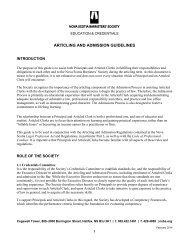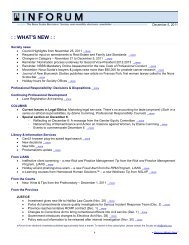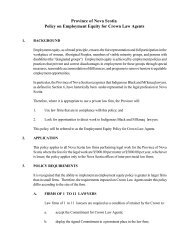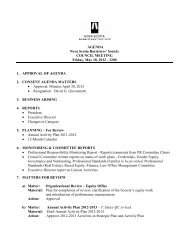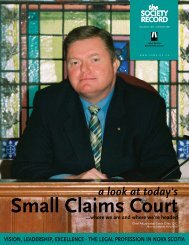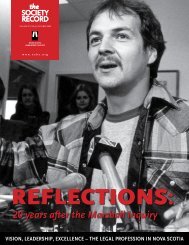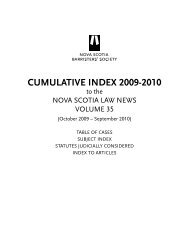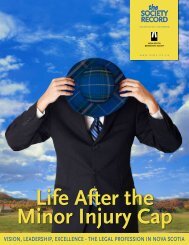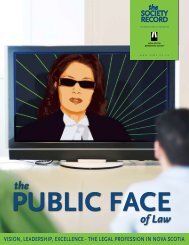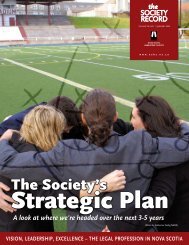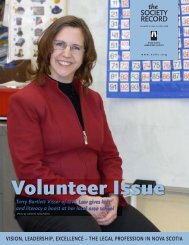fostering employment equity and diversity in the nova scotia legal
fostering employment equity and diversity in the nova scotia legal
fostering employment equity and diversity in the nova scotia legal
Create successful ePaper yourself
Turn your PDF publications into a flip-book with our unique Google optimized e-Paper software.
FOSTERING EMPLOYMENT EQUITY AND DIVERSITY<br />
IN THE NOVA SCOTIA LEGAL PROFESSION<br />
Employment Equity Guidel<strong>in</strong>es Committee<br />
August 2000
THE EMPLOYMENT EQUITY GUIDELINES COMMITTEE<br />
The Employment Equity Guidel<strong>in</strong>es Committee was established <strong>in</strong> February 1999 by <strong>the</strong><br />
Honourable Russell MacLellan.<br />
After consultation with <strong>the</strong> various constituents <strong>the</strong> follow<strong>in</strong>g <strong>in</strong>dividuals were selected to serve<br />
on <strong>the</strong> committee:<br />
Chair<br />
Nova Scotia Barrister’s Society<br />
Mr. Douglas G. Ruck, Q.C.<br />
Nova Scotia Office of <strong>the</strong> Ombudsman<br />
Mr. Craig M. Garson, Q.C. 2 nd Vice President<br />
Garson, Knox & MacDonald<br />
Mr. Robert G. MacKeigan, Q.C.<br />
Cox Hanson O’Reilly Ma<strong>the</strong>son<br />
Dalhousie Law School<br />
Ms. Carol A. Aylward, Director<br />
Law Programme for Indigenous Black & Mi’kmaq<br />
Mr. Innis Christie, Q.C., Professor<br />
Dalhousie Law School<br />
Dalhousie Black Law Students’<br />
Association<br />
Dalhousie Aborig<strong>in</strong>al Law Students’<br />
Association<br />
Department of Justice<br />
Ms. Cora States, President<br />
Dalhousie Black Law Students’ Association<br />
Ms. C<strong>and</strong>y Palmater, President<br />
Dalhousie Aborig<strong>in</strong>al Law Students’ Association<br />
Mr. Douglas Keefe, Executive Director<br />
Legal Services<br />
Ms. Margaret MacDonald, Solicitor<br />
Legal Services<br />
Black Lawyers’ Association of Nova<br />
Scotia<br />
Mi’kmaq Justice Institute<br />
Mr. Burnley A. (Rocky) Jones<br />
B.A. “Rocky” Jones & Associates<br />
Ms. Heidi Marshall<br />
Executive Director
Ms. Heidi Marshall was unable to cont<strong>in</strong>ue as <strong>the</strong> appo<strong>in</strong>tee of <strong>the</strong> Mi’kmaq Justice Institute <strong>and</strong><br />
was replaced by Ms. Hea<strong>the</strong>r McNeill. Ms. Cora States <strong>and</strong> Ms. C<strong>and</strong>y Palmater graduated from<br />
Dalhousie Law School <strong>and</strong> Mr. Kelv<strong>in</strong> Gilp<strong>in</strong> was elected President of <strong>the</strong> Dalhousie Black Law<br />
Students’ Association. Ms. Judith Ferguson replaced Ms. Margaret MacDonald as <strong>the</strong><br />
Department of Justice appo<strong>in</strong>tee.<br />
The committee presently consists of <strong>the</strong> follow<strong>in</strong>g members:<br />
Chair<br />
Nova Scotia Barristers’ Society<br />
Mr. Douglas G. Ruck, Q.C.<br />
Nova Scotia Office of <strong>the</strong> Ombudsman<br />
Mr. Craig M. Garson, Q.C. 2 nd Vice President<br />
Garson, Knox & MacDonald<br />
Mr. Robert G. MacKeigan, Q.C.<br />
Cox Hanson O’Reilly Ma<strong>the</strong>son<br />
Dalhousie Law School<br />
Ms. Carol A. Aylward, Director<br />
Law Programme for Indigenous Black & Mi’kmaq<br />
Mr. Innis Christie, Q.C. Professor<br />
Dalhousie Law School<br />
Dalhousie Black Law Students’<br />
Association<br />
Department of Justice<br />
Mr. Kelv<strong>in</strong> Gilp<strong>in</strong>, President<br />
Dalhousie Black Law Students’ Association<br />
Mr. Douglas Keefe, Executive Director<br />
Legal Services<br />
Ms. Judith Ferguson, Solicitor<br />
Legal Services<br />
Black Lawyers’ Association of Nova<br />
Scotia<br />
Mi’kmaq Justice Institute<br />
Mr. Burnley A. (Rocky) Jones<br />
B.A. “Rocky” Jones & Associates<br />
Ms. Hea<strong>the</strong>r McNeill<br />
Dalhousie Legal Aid
The Committee wishes to thank <strong>the</strong> follow<strong>in</strong>g <strong>in</strong>dividuals for <strong>the</strong>ir assistance, advice <strong>and</strong><br />
adm<strong>in</strong>istrative support:<br />
Non Vot<strong>in</strong>g<br />
Premier’s Office Liaison<br />
Premier’s Office Liaison<br />
Nova Scotia Barristers’ Society<br />
Nova Scotia Barristers’ Society<br />
Department of Justice<br />
Ms. Alana Patterson<br />
Advisor, Priorities & Plann<strong>in</strong>g Secretariat<br />
Ms. K<strong>and</strong>ace Terris<br />
Senior Policy Analyst<br />
(replaced Mrs. Patterson follow<strong>in</strong>g <strong>the</strong> 1999<br />
prov<strong>in</strong>cial election)<br />
Ms. Ca<strong>the</strong>r<strong>in</strong>e Meade, Equity Officer<br />
Nova Scotia Barristers’ Society<br />
Ms. Hea<strong>the</strong>r Ch<strong>and</strong>ler, Equity Officer<br />
Nova Scotia Barristers’ Society<br />
(assumed position of Equity Officer when Ms.<br />
Meade relocated to Ottawa)<br />
Ms. Aleta Cromwell, Solicitor
To <strong>the</strong> Honourable Michael Baker, Q.C.<br />
M<strong>in</strong>ister of Justice<br />
The Employment Equity Guidel<strong>in</strong>es Committee is pleased to present it’s report Foster<strong>in</strong>g<br />
Employment Equity <strong>and</strong> Diversity <strong>in</strong> <strong>the</strong> Nova Scotia Legal Profession.<br />
Mr. Douglas G. Ruck, Q.C.<br />
Chair<br />
Mr. Burnley A. (Rocky) Jones<br />
Ms. Carol A. Aylward<br />
Ms. Hea<strong>the</strong>r McNeill<br />
Mr. Innis Christie, Q.C<br />
Mr. Kelv<strong>in</strong> Gilp<strong>in</strong><br />
* subject to addendum comments<br />
Mr. Douglas Keefe *<br />
* subject to addendum comments<br />
Ms. Judith Ferguson *
TABLE OF CONTENTS<br />
PART I ...................................................................1<br />
INTRODUCTION ..........................................................2<br />
THE COMMITTEE’S APPROACH TO THE TASK ................................4<br />
EMPLOYMENT EQUITY AND THE CANADIAN CHARTER OF RIGHTS AND<br />
FREEDOMS .........................................................5<br />
THE NOVA SCOTIA BARRISTERS’ SOCIETY AND RULE 24 ......................6<br />
TALKING ABOUT DIVERSITY AND RACISM ..................................9<br />
THE STATISTICAL PICTURE ...............................................11<br />
INDIGENOUS BLACKS AND MI’KMAQ PROGRAMME DATA: .............12<br />
INDIGENOUS BLACKS AND MI’KMAQ PROGRAMME: Employment data: .....13<br />
EQUITY HIRING GUIDELINES - AN OVERVIEW ...............................16<br />
PART II .................................................................18<br />
EMPLOYMENT EQUITY AND AFFIRMATIVE ACTION POLICY ..................19<br />
BACKGROUND .....................................................19<br />
POLICY STATEMENT OF THE LEGAL SERVICES DIVISION ...............19<br />
EMPLOYMENT EQUITY AND AFFIRMATIVE ACTION POLICY FOR CROWN LAW<br />
AGENTS ...........................................................20<br />
BACKGROUND .....................................................20<br />
POLICY STATEMENT ...............................................20<br />
APPLICATION ......................................................20<br />
CONDITIONS OF RETAINER ..........................................21<br />
REQUIREMENTS FOR AN ACTION PLAN ..............................21<br />
MONITORING AND REMEDIES .......................................23<br />
DEFINITIONS ......................................................25<br />
COMMITMENT FOR CROWN LAW AGENTS ..................................26<br />
PART III ................................................................27<br />
REGULATIONS MADE UNDER THE<br />
GOVERNMENT PURCHASES ACT ......................................28
APPENDIX A ............................................................31<br />
APPENDIX B ............................................................35<br />
BIBLIOGRAPHY ....................................................36<br />
ADDENDUM .............................................................41<br />
EMPLOYMENT EQUITY - ADDENDUM ................................42
PART I<br />
1
FOSTERING EMPLOYMENT EQUITY AND DIVERSITY<br />
IN THE NOVA SCOTIA LEGAL PROFESSION<br />
INTRODUCTION<br />
The Prov<strong>in</strong>ce of Nova Scotia has, for many years, attempted, through a variety of means, to<br />
address issues of <strong>diversity</strong> <strong>and</strong> affirmative action. However, despite <strong>the</strong> lessons of history <strong>the</strong>re<br />
are still those who question <strong>the</strong> need for programs <strong>and</strong> policies that promote, encourage <strong>and</strong><br />
enforce equality. Even though significant advances have been made on many fronts Nova Scotia<br />
cont<strong>in</strong>ues to struggle with issues of <strong>in</strong>equality. As with many problems faced by society,<br />
acknowledg<strong>in</strong>g <strong>the</strong> existence of <strong>the</strong> problem is <strong>the</strong> first step towards develop<strong>in</strong>g solutions.<br />
History has clearly shown that ignor<strong>in</strong>g <strong>the</strong> problems or pretend<strong>in</strong>g <strong>the</strong>y do not exist has never<br />
served as a means of resolution. The historical patterns of exclusion <strong>and</strong> differential treatment<br />
serve as one of <strong>the</strong> most significant hurdles to capitaliz<strong>in</strong>g upon <strong>the</strong> strength of our grow<strong>in</strong>g<br />
<strong>diversity</strong>. The answer to <strong>the</strong> problem is not to be found <strong>in</strong> catchy phrases <strong>and</strong>/or wish<strong>in</strong>g for<br />
change. Private <strong>and</strong> public bus<strong>in</strong>esses <strong>and</strong> <strong>in</strong>stitutions must do more than simply state “we support<br />
equal opportunity”. The barriers will not be removed as a consequence of simple pronouncements<br />
or one-time cultural awareness programs.<br />
In Nova Scotia we need only look at our history to see that equal rights have never been provided<br />
voluntarily. Repeatedly, it has been shown that progress has only been achieved through<br />
enforcement mechanisms <strong>in</strong>clud<strong>in</strong>g legislation, regulatory requirements <strong>and</strong> judicial review. This<br />
has been reflected <strong>in</strong> all segments of society <strong>in</strong>clud<strong>in</strong>g education, hous<strong>in</strong>g <strong>and</strong> <strong>employment</strong>.<br />
Affirmative action <strong>and</strong> <strong>equity</strong> programs are not to be viewed as <strong>the</strong> panacea to correct all <strong>the</strong><br />
socio-economic problems of society. Unfortunately however, such programs are often represented<br />
as concerned exclusively with quotas or hav<strong>in</strong>g <strong>the</strong> result of lower<strong>in</strong>g st<strong>and</strong>ards by hir<strong>in</strong>g <strong>and</strong><br />
promot<strong>in</strong>g unqualified people. This position, however, has never been supported by reference to<br />
any specific laws, regulations or programs, that require an employer to lower st<strong>and</strong>ards or hire <strong>the</strong><br />
unqualified.<br />
Diversity <strong>in</strong>itiatives are required to meet <strong>the</strong> changes which are on <strong>the</strong> horizon for Nova Scotia.<br />
As <strong>the</strong> work force changes <strong>the</strong> pressure to accommodate different cultural values will <strong>in</strong>crease.<br />
The issues are complex <strong>and</strong> will <strong>in</strong>variably affect <strong>the</strong> entire workforce of Nova Scotia. This report,<br />
however, is concerned primarily with <strong>employment</strong> of <strong>in</strong>digenous Black <strong>and</strong> Mi’kmaq <strong>in</strong> <strong>the</strong> <strong>legal</strong><br />
profession.<br />
In February 1999, <strong>the</strong>n Premier, Russell MacLellan, announced <strong>the</strong> formation of <strong>the</strong> Employment<br />
Equity Guidel<strong>in</strong>es Committee to develop guidel<strong>in</strong>es to <strong>in</strong>crease <strong>the</strong> number of <strong>in</strong>digenous Black<br />
2
<strong>and</strong> native lawyers employed at law firms <strong>in</strong> Nova Scotia. In particular <strong>the</strong> Premier stated that <strong>the</strong><br />
m<strong>and</strong>ate of <strong>the</strong> committee is to recommend <strong>employment</strong> <strong>equity</strong> guidel<strong>in</strong>es for all firms that do<br />
bus<strong>in</strong>ess with <strong>the</strong> prov<strong>in</strong>cial government. (Appendix “A”).<br />
The m<strong>and</strong>ate of <strong>the</strong> committee was confirmed by Premier John Hamm <strong>in</strong> his letter of December<br />
1999 <strong>and</strong> attached hereto as Appendix “A”.<br />
3
THE COMMITTEE’S APPROACH TO THE TASK<br />
As a consequence of vary<strong>in</strong>g levels of underst<strong>and</strong><strong>in</strong>g <strong>and</strong> differences <strong>in</strong> background <strong>the</strong> first step<br />
<strong>in</strong> <strong>the</strong> process was to exam<strong>in</strong>e exist<strong>in</strong>g federal <strong>and</strong> prov<strong>in</strong>cial legislation, regulations, policies <strong>and</strong><br />
programs. Particular attention was paid to Section 15 of <strong>the</strong> Canadian Charter of Rights <strong>and</strong><br />
Freedoms.<br />
We also conducted a review of <strong>the</strong> programs <strong>and</strong> policies <strong>in</strong> place <strong>in</strong> o<strong>the</strong>r Canadian prov<strong>in</strong>ces<br />
<strong>and</strong> <strong>in</strong> <strong>the</strong> United States of America. See Appendix “A” for a complete list of <strong>the</strong> material<br />
reviewed by <strong>the</strong> committee.<br />
The committee also <strong>in</strong>vited several prov<strong>in</strong>cial <strong>and</strong> federal representatives to make presentations on<br />
<strong>the</strong>ir experiences with design<strong>in</strong>g <strong>and</strong> implement<strong>in</strong>g affirmative action <strong>and</strong> <strong>equity</strong> programs.<br />
The consultation process served several important purposes:<br />
S it provided for <strong>the</strong> <strong>in</strong>volvement of o<strong>the</strong>rs <strong>in</strong> <strong>the</strong> process to assist <strong>in</strong> develop<strong>in</strong>g sound <strong>and</strong><br />
workable <strong>employment</strong> <strong>equity</strong> guidel<strong>in</strong>es<br />
S it gave <strong>the</strong> committee <strong>in</strong>sight <strong>and</strong> an opportunity to discuss <strong>and</strong> explore <strong>the</strong> issues surround<strong>in</strong>g<br />
<strong>employment</strong> <strong>equity</strong><br />
S it provided an explanation of <strong>the</strong> rationale beh<strong>in</strong>d <strong>the</strong> exist<strong>in</strong>g programs<br />
4
EMPLOYMENT EQUITY AND THE CANADIAN CHARTER OF RIGHTS AND<br />
FREEDOMS<br />
The Canadian Charter of Rights <strong>and</strong> Freedoms recognizes <strong>the</strong> need for special programs to<br />
elim<strong>in</strong>ate discrim<strong>in</strong>atory practices <strong>and</strong> redress imbalances. Section 15 states:<br />
15 (1) Every <strong>in</strong>dividual is equal before <strong>and</strong> under <strong>the</strong> law <strong>and</strong> has <strong>the</strong> right to <strong>the</strong> equal<br />
protection <strong>and</strong> equal benefit of <strong>the</strong> law without discrim<strong>in</strong>ation based on race, national or<br />
ethnic orig<strong>in</strong>, colour, religion, sex, age or mental or physical disability.<br />
(2) Subsection (1) does not preclude any law, program, or activity that has as its object<br />
<strong>the</strong> amelioration of conditions of disadvantaged <strong>in</strong>dividuals or groups <strong>in</strong>clud<strong>in</strong>g those that<br />
are disadvantaged because of race, national or ethnic orig<strong>in</strong>, colour, religion, sex, age, or<br />
mental or physical disability.<br />
The committee accepts that <strong>the</strong> reduction <strong>and</strong> eventual elim<strong>in</strong>ation of <strong>the</strong> circumstances <strong>and</strong><br />
conditions that have prevented certa<strong>in</strong> groups from atta<strong>in</strong><strong>in</strong>g <strong>employment</strong> <strong>equity</strong> is a constitutional<br />
goal <strong>and</strong> Section 15 requires a broad <strong>and</strong> generous <strong>in</strong>terpretation. Moreover <strong>the</strong> committee<br />
accepts that Section 15 supports <strong>the</strong> pr<strong>in</strong>ciple that <strong>employment</strong> <strong>equity</strong> means more than treat<strong>in</strong>g<br />
people <strong>in</strong> <strong>the</strong> same way but also requires special measures <strong>and</strong> <strong>the</strong> accommodation of differences.<br />
5
THE NOVA SCOTIA BARRISTERS’ SOCIETY AND RULE 24<br />
The Nova Scotia Barristers’ Society has recognized that <strong>the</strong> <strong>legal</strong> profession must not only reflect<br />
<strong>the</strong> <strong>diversity</strong> of <strong>the</strong> society it serves, but also embrace <strong>the</strong> belief that fair representation <strong>and</strong> equal<br />
access are essential to ensure a system of justice that is unbiased. The Barristers’ Society adopted<br />
specific language proscrib<strong>in</strong>g discrim<strong>in</strong>atory practices by lawyers. In its Rules of Legal Ethics <strong>and</strong><br />
Professional Conduct <strong>the</strong> Bar Society at Rule 24 states:<br />
24. Discrim<strong>in</strong>ation<br />
Rule<br />
A lawyer has a duty to respect <strong>the</strong> human dignity <strong>and</strong> worth of all persons <strong>and</strong> to<br />
treat all persons with equality <strong>and</strong> without discrim<strong>in</strong>ation.<br />
Guid<strong>in</strong>g Pr<strong>in</strong>ciples<br />
A lawyer discrim<strong>in</strong>ates <strong>in</strong> contravention of this Rule when a lawyer makes a<br />
dist<strong>in</strong>ction based on an irrelevant characteristic or perceived characteristic of an<br />
<strong>in</strong>dividual or group such as age, race, colour, religion, creed, sex, sexual<br />
orientation, disability, ethnic, national or aborig<strong>in</strong>al orig<strong>in</strong>, family status, marital<br />
status, source of <strong>in</strong>come, political belief or affiliation, if <strong>the</strong> dist<strong>in</strong>ction has <strong>the</strong><br />
effect of impos<strong>in</strong>g burdens, obligations, or disadvantages on an <strong>in</strong>dividual or on a<br />
group not imposed on o<strong>the</strong>rs or if <strong>the</strong> dist<strong>in</strong>ction has <strong>the</strong> effect of withhold<strong>in</strong>g or<br />
limit<strong>in</strong>g access to opportunities, benefits, or advantages available to <strong>in</strong>dividuals or<br />
groups <strong>in</strong> society.<br />
Commentary<br />
24.1 A lawyer has a duty to ensure that no one is denied services or receives<br />
<strong>in</strong>ferior service because of any irrelevant characteristics or beliefs <strong>in</strong>clud<strong>in</strong>g those<br />
enumerated <strong>in</strong> <strong>the</strong> Guid<strong>in</strong>g Pr<strong>in</strong>ciples.<br />
24.2 A lawyer has a duty to ensure that <strong>the</strong> lawyer's <strong>employment</strong> practices do not<br />
offend <strong>the</strong> Rule or <strong>the</strong> Guid<strong>in</strong>g Pr<strong>in</strong>ciples.<br />
24.3 This Rule should be read <strong>in</strong> conjunction with Chapters 1 <strong>and</strong> 23 <strong>and</strong><br />
Commentary 18.9.1<br />
24.4 This Rule does not preclude mak<strong>in</strong>g dist<strong>in</strong>ctions<br />
(a) based on a bona fide qualification, or<br />
6
(b) where such discrim<strong>in</strong>ation is a reasonable limit prescribed by law as can be<br />
demonstrably justified <strong>in</strong> a free <strong>and</strong> democratic society.<br />
24.5 This Rule does not apply to bona fide retirement or pension plans or terms<br />
<strong>and</strong> conditions of group or employee <strong>in</strong>surance plans based on age, or bona fide<br />
m<strong>and</strong>atory retirement plans, schemes or practices.<br />
24.6 This Rule does not preclude any program, activity or affirmative action that<br />
has as its object <strong>the</strong> amelioration of conditions or disadvantages for <strong>in</strong>dividuals or<br />
groups <strong>in</strong>clud<strong>in</strong>g those who are disadvantaged because of a characteristic referred<br />
to <strong>in</strong> <strong>the</strong> Guid<strong>in</strong>g Pr<strong>in</strong>ciples.<br />
The Barristers’ Society also provided <strong>the</strong> follow<strong>in</strong>g notes to Rule 24 to assist its members<br />
to better underst<strong>and</strong> <strong>and</strong> appreciate <strong>the</strong> significance of Rule 24:<br />
Notes<br />
1. A lawyer has a duty to become familiar with <strong>and</strong> underst<strong>and</strong> Section 15 of <strong>the</strong><br />
Canadian Charter of Rights <strong>and</strong> Freedoms <strong>and</strong> prov<strong>in</strong>cial <strong>and</strong> federal human rights<br />
legislation. A lawyer should cultivate a knowledge <strong>and</strong> underst<strong>and</strong><strong>in</strong>g of Canadian<br />
jurisprudence on <strong>the</strong> mean<strong>in</strong>g of equality <strong>and</strong> discrim<strong>in</strong>ation <strong>and</strong> on adverse impact<br />
analysis, both of which warn of <strong>the</strong> danger of assum<strong>in</strong>g that good <strong>in</strong>tentions or<br />
uniform rules necessarily accomplish equality.<br />
2. In <strong>the</strong> case of Gene Keys v. P<strong>and</strong>ora Publish<strong>in</strong>g Association (March 17, 1992),<br />
a Nova Scotia Human Rights Board of Inquiry held that <strong>in</strong> order to achieve<br />
equality for a disadvantaged group, sometimes <strong>the</strong> different treatment of<br />
non-disadvantaged groups was necessary. That case <strong>in</strong>volved a compla<strong>in</strong>t by a man<br />
aga<strong>in</strong>st a fem<strong>in</strong>ist newspaper that refused to pr<strong>in</strong>t his letter to <strong>the</strong> editor <strong>in</strong> <strong>the</strong><br />
newspaper. He claimed that he was be<strong>in</strong>g discrim<strong>in</strong>ated aga<strong>in</strong>st on <strong>the</strong> basis of sex.<br />
The Board of Inquiry stated:<br />
I am also satisfied that as a matter of law <strong>the</strong> concepts of equality <strong>and</strong><br />
discrim<strong>in</strong>ation under <strong>the</strong> Act must be consistent with those concepts <strong>in</strong> <strong>the</strong> Charter.<br />
McIntyre, J. <strong>in</strong> Andrews stated that <strong>the</strong> promotion of equality <strong>in</strong> <strong>the</strong> prohibition<br />
aga<strong>in</strong>st discrim<strong>in</strong>ation has a more specific goal than <strong>the</strong> mere elim<strong>in</strong>ation of<br />
dist<strong>in</strong>ctions <strong>and</strong> that identical treatment may produce <strong>in</strong>equality. It follows,<br />
accord<strong>in</strong>gly, that a disadvantaged group may undertake a program or activity<br />
which has as its object <strong>the</strong> amelioration of conditions of disadvantaged <strong>in</strong>dividuals<br />
or classes of <strong>in</strong>dividuals <strong>in</strong>clud<strong>in</strong>g those discrim<strong>in</strong>ated aga<strong>in</strong>st on <strong>the</strong> basis of sex<br />
even if that results <strong>in</strong> dist<strong>in</strong>ctions be<strong>in</strong>g made with respect to <strong>the</strong> advantaged<br />
group.<br />
7
It is important to note that Rule 24 at 24.6 reflects <strong>and</strong> supports <strong>the</strong> same pr<strong>in</strong>ciple<br />
as found at Section 15(2) of <strong>the</strong> Canadian Charter of Rights <strong>and</strong> Freedoms. The<br />
role <strong>and</strong> need for special programs to elim<strong>in</strong>ate discrim<strong>in</strong>atory practices <strong>and</strong><br />
redress imbalances.<br />
8
TALKING ABOUT DIVERSITY AND RACISM<br />
The members of <strong>the</strong> <strong>employment</strong> <strong>equity</strong> committee represent a microcosm of <strong>the</strong> Nova Scotia<br />
<strong>legal</strong> community. The committee consists of members of <strong>the</strong> private bar, academics, government<br />
lawyers, law students, senior counsel, African Canadians, First Nations <strong>and</strong> article clerks. It soon<br />
became evident that <strong>the</strong> members came to <strong>the</strong> committee with diverse views <strong>and</strong> vary<strong>in</strong>g levels of<br />
underst<strong>and</strong><strong>in</strong>g, knowledge <strong>and</strong> experience of <strong>employment</strong> <strong>equity</strong>.<br />
Talk<strong>in</strong>g about <strong>diversity</strong> <strong>and</strong> racism is not an easy task, particularly <strong>in</strong> a group that consists of<br />
people of o<strong>the</strong>r races, classes, gender <strong>and</strong> status. But if progress is to be made we must learn to<br />
discuss race openly <strong>and</strong> effectively <strong>in</strong> order to collaborate <strong>in</strong> programs <strong>and</strong> <strong>in</strong>itiatives that will<br />
make our <strong>in</strong>creas<strong>in</strong>gly ethnic diverse society productive <strong>and</strong> functional.<br />
As difficult as some may f<strong>in</strong>d it to talk about race it is equally true that it is often just as difficult<br />
to listen. The difficulty is sometimes due to <strong>the</strong> fact that we do not wish to listen or perhaps we<br />
do not know how to listen. Attempts at conversation often produce discomfort, heated<br />
<strong>in</strong>teractions <strong>and</strong> patterns of attack <strong>and</strong> defense that deteriorate <strong>in</strong>to debate <strong>and</strong> argument ra<strong>the</strong>r<br />
than dialogue.<br />
Talk<strong>in</strong>g about race forces us to look at ourselves, our own prejudices, privileges <strong>and</strong> suffer<strong>in</strong>g. As<br />
well, we br<strong>in</strong>g to <strong>the</strong> table different levels of underst<strong>and</strong><strong>in</strong>g or <strong>in</strong>formation about race <strong>and</strong> racism.<br />
We are sometimes reluctant to talk about race because of <strong>the</strong> fear of expos<strong>in</strong>g our ignorance or<br />
lack of underst<strong>and</strong><strong>in</strong>g of <strong>the</strong> issues.<br />
Talk alone does not lead to change. The work of <strong>the</strong> committee must lead to action, to well<br />
conceived, well developed <strong>and</strong> well implemented programs that will address <strong>the</strong> systemic<br />
manifestations of racism that exist with<strong>in</strong> <strong>the</strong> <strong>legal</strong> community.<br />
The first step of <strong>the</strong> committee has been to talk <strong>and</strong> learn how to underst<strong>and</strong>, explore <strong>and</strong> deal<br />
with personal <strong>and</strong> <strong>in</strong>stitutional racism <strong>and</strong> to collaborate with <strong>the</strong>ir fellow committee members to<br />
structure guidel<strong>in</strong>es that <strong>in</strong> <strong>the</strong> words of Judge Rosalie Abella constitute a “strategy designed to<br />
obliterate <strong>the</strong> present <strong>and</strong> <strong>the</strong> residual effects of discrim<strong>in</strong>ation <strong>and</strong> to open equitably <strong>the</strong><br />
competition for <strong>employment</strong> opportunities to those arbitrarily excluded. It requires a special blend<br />
of what is necessary, what is fair <strong>and</strong> what is workable.”<br />
If we are to effectively address discrim<strong>in</strong>ation <strong>and</strong> racism we must acknowledge <strong>the</strong>ir long history<br />
<strong>in</strong> language. In this world of politically dom<strong>in</strong>ant <strong>and</strong> sub dom<strong>in</strong>ant peoples <strong>the</strong> language of <strong>the</strong><br />
dom<strong>in</strong>ant or elite will generally hold sway. In his book Elite Discourse <strong>and</strong> Racism, Newbury<br />
Park, CA: Sage, 1993, Teun A. van Dijk, contends that a politically dom<strong>in</strong>ant group’s language<br />
can def<strong>in</strong>e situations <strong>and</strong> impose certa<strong>in</strong> mean<strong>in</strong>gs on situations. Consequently <strong>the</strong> non dom<strong>in</strong>ant<br />
group may unwitt<strong>in</strong>gly f<strong>in</strong>d that it is ensnared <strong>in</strong> language which is pejorative. This occurrence<br />
may lead to loss of self esteem <strong>and</strong> self confidence. Therefore <strong>the</strong> move towards a redef<strong>in</strong>ition of<br />
9
terms by previously oppressed peoples is a rega<strong>in</strong><strong>in</strong>g of self esteem <strong>and</strong> an <strong>in</strong>crease <strong>in</strong> confidence.<br />
Language may also be utilized as a smoke screen. Thus a person may be say<strong>in</strong>g one th<strong>in</strong>g while<br />
th<strong>in</strong>k<strong>in</strong>g <strong>and</strong> mean<strong>in</strong>g someth<strong>in</strong>g else. While this may be an unconscious occurrence it is also<br />
possible as conscious process<strong>in</strong>g. It is not an uncommon occurrence to learn that someone has not<br />
been hired or kept on by a firm because it was not <strong>the</strong> right “fit”. The term “fit”, however, may<br />
mask a conscious or unconscious discrim<strong>in</strong>atory practice with<strong>in</strong> <strong>the</strong> hir<strong>in</strong>g process. “Fit” when<br />
used <strong>in</strong> this context is generally a reflection of one’s personal or cultural assessments derived from<br />
shared values with c<strong>and</strong>idates ra<strong>the</strong>r than a comparison of skills. If such is <strong>the</strong> case <strong>the</strong> result is an<br />
unfair barrier.<br />
10
THE STATISTICAL PICTURE<br />
The Royal Commission <strong>in</strong>to <strong>the</strong> Donald Marshall Junior prosecution recognized that historically<br />
Blacks <strong>and</strong> Mi’kmaqs have been excluded from <strong>the</strong> practice of law. The Royal Commission<br />
recommended that <strong>the</strong> Government of Nova Scotia, <strong>the</strong> Nova Scotia Barristers’ Society <strong>and</strong> <strong>the</strong><br />
Dalhousie Faculty of Law co-operate <strong>in</strong> <strong>the</strong> development of a program to identify, recruit <strong>and</strong><br />
support qualified Black <strong>and</strong> Mi’kmaq students aspir<strong>in</strong>g to <strong>legal</strong> careers.<br />
Prior to <strong>the</strong> Marshall Inquiry <strong>the</strong>re were n<strong>in</strong>e Black lawyers <strong>in</strong> <strong>the</strong> prov<strong>in</strong>ce of Nova Scotia not all<br />
of whom were practic<strong>in</strong>g law. The first native born Black Nova Scotian to graduate from<br />
Dalhousie Law School was James Rob<strong>in</strong>son Johnston <strong>in</strong> 1898. It was fifty-four years later that<br />
<strong>the</strong> next native born Black Nova Scotian graduated <strong>in</strong> 1952.<br />
It was <strong>in</strong> <strong>the</strong> 1960's that <strong>the</strong> first Black lawyer was hired by a private law firm. From <strong>the</strong> 1970's to<br />
<strong>the</strong> time of <strong>the</strong> <strong>in</strong>troduction of <strong>the</strong> Indigenous Blacks <strong>and</strong> Mi’kmaq Programme at Dalhousie Law<br />
School <strong>in</strong> 1989 <strong>the</strong>re were five <strong>in</strong>digenous Black Nova Scotia graduates.<br />
In <strong>the</strong> case of Mi’kmaq lawyers, prior to <strong>the</strong> Indigenous Black <strong>and</strong> Mi’kmaq Programme, <strong>the</strong>re<br />
were no Mi’kmaq lawyers <strong>in</strong> Nova Scotia. The 1876 Indian Act specifically provided that any<br />
Aborig<strong>in</strong>al person admitted to medical or law school would be enfranchised under <strong>the</strong> provisions<br />
of <strong>the</strong> Act. The provision was repealed <strong>in</strong> 1951 but it must be acknowledged that <strong>the</strong> defacto<br />
exclusion existed until <strong>the</strong> implementation of <strong>the</strong> Indigenous Blacks <strong>and</strong> Mi’kmaq Programme <strong>in</strong><br />
1989. In 1992, <strong>the</strong> first Mi’kmaq graduated from Dalhousie Law School <strong>and</strong> it was <strong>in</strong> 2000 when<br />
<strong>the</strong> first Mi’kmaq was hired as a lawyer by a private law firm. 1<br />
The statistical <strong>in</strong>formation with respect to <strong>the</strong> number of Indigenous Blacks <strong>and</strong> Mi’kmaq <strong>in</strong> <strong>the</strong><br />
<strong>legal</strong> profession <strong>in</strong> Nova Scotia has shown a slight amelioration but <strong>in</strong> <strong>the</strong> absence of<br />
implement<strong>in</strong>g <strong>employment</strong> <strong>equity</strong> guidel<strong>in</strong>es <strong>the</strong> picture is not promis<strong>in</strong>g. There is a marked<br />
imbalance <strong>in</strong> <strong>the</strong> <strong>legal</strong> community particularly <strong>in</strong> <strong>the</strong> private bar.<br />
The current statistical <strong>in</strong>formation as set out at pages 12 to 15 <strong>in</strong>dicates that <strong>the</strong>re has been<br />
<strong>in</strong>cremental progress. In o<strong>the</strong>r words <strong>the</strong> <strong>legal</strong> profession as a whole has shown an <strong>in</strong>crease <strong>in</strong> <strong>the</strong><br />
number of Indigenous Blacks <strong>and</strong> Mi’kmaq lawyers. The most dramatic <strong>in</strong>crease has been <strong>in</strong> <strong>the</strong><br />
number of Indigenous Blacks <strong>and</strong> Mi’kmaq students attend<strong>in</strong>g law school. There is little question<br />
that this dramatic rise relates directly to <strong>the</strong> IB&M program that was <strong>in</strong>troduced at Dalhousie<br />
Law School <strong>in</strong> 1989.<br />
Despite <strong>the</strong> <strong>in</strong>crease <strong>in</strong> <strong>the</strong> number of law students <strong>and</strong> graduates <strong>the</strong>re has been only <strong>in</strong>cremental<br />
progress, particularly <strong>in</strong> <strong>the</strong> area of private practice. The <strong>in</strong>crease has been marg<strong>in</strong>al at best <strong>and</strong><br />
1 The Race Relations Committee of <strong>the</strong> Nova Scotia Barristers’ Society commissioned a report on <strong>the</strong><br />
Aborig<strong>in</strong>al Lawyers Survey. The document is presently <strong>in</strong> draft form <strong>and</strong> was not available to <strong>the</strong> Committee.<br />
11
advancement with<strong>in</strong> <strong>the</strong> firms appears to be m<strong>in</strong>imal. There cont<strong>in</strong>ue to exist formidable obstacles<br />
to full <strong>and</strong> equal participation with<strong>in</strong> <strong>the</strong> private bar.<br />
The Nova Scotia government <strong>and</strong> <strong>in</strong> particular <strong>the</strong> Department of Justice, as shown by <strong>the</strong><br />
statistical <strong>in</strong>formation, has hired graduates of <strong>the</strong> IB&M Program. It must be noted, however,<br />
that consistent with current government hir<strong>in</strong>g policies <strong>the</strong> graduates have not been hired as<br />
permanent full time employees but ra<strong>the</strong>r on a contract basis. Government is <strong>the</strong>refore<br />
encouraged to exam<strong>in</strong>e its hir<strong>in</strong>g policy <strong>in</strong> light of <strong>the</strong> impact it has upon <strong>the</strong> retention <strong>and</strong><br />
promotion of Indigenous Black <strong>and</strong> Mi’kmaq lawyers with<strong>in</strong> government.<br />
The difficulties <strong>and</strong> obstacles experienced by Indigenous Blacks <strong>and</strong> Mi’kmaq lawyers at <strong>the</strong><br />
private bar is <strong>in</strong>dicative of <strong>the</strong> <strong>in</strong>equities that have existed historically with<strong>in</strong> <strong>the</strong> Prov<strong>in</strong>ce of Nova<br />
Scotia. The struggle however to remedy <strong>and</strong> redress past <strong>and</strong> present <strong>in</strong>equities is ongo<strong>in</strong>g. The<br />
legacy of racism will not on its own volition wi<strong>the</strong>r <strong>and</strong> go away ra<strong>the</strong>r it requires <strong>the</strong> assistance<br />
of those <strong>in</strong> positions of power <strong>and</strong> <strong>in</strong>fluence. Government <strong>and</strong> our political leaders occupy such a<br />
position <strong>and</strong> by <strong>the</strong>ir efforts can make <strong>the</strong> greatest strides towards remov<strong>in</strong>g <strong>the</strong> systemic barriers<br />
to full <strong>and</strong> equal participation at all levels of society.<br />
INDIGENOUS BLACKS AND MI’KMAQ PROGRAMME DATA:<br />
GRADUATES<br />
Number of Graduates s<strong>in</strong>ce 1989 63<br />
Number of Black Graduates 37<br />
Number of Mi’kmaq Graduates 26<br />
Number of Indigenous Black Graduates 35<br />
Number of Non-Indigenous Black Graduates 02<br />
NUMBER OF STUDENTS CURRENTLY ENROLLED IN THE IB&M PROGRAM<br />
{28 First, Second, <strong>and</strong> Third Years}<br />
Black Students<br />
Number of Indigenous Black Students 12<br />
Number of Non-Indigenous Black Students 09<br />
12
Mi’kmaq Students<br />
Number of Mi’kmaq Students 07<br />
INDIGENOUS BLACKS AND MI’KMAQ PROGRAMME: Employment data:<br />
Graduate Employment Report<br />
[<strong>the</strong> follow<strong>in</strong>g data tracks graduates from 1992 (first graduat<strong>in</strong>g class) through 2000]<br />
1992<br />
Four Graduates<br />
One is a Private Sole Practitioner<br />
One is a Government lawyer (Workers’ Advocacy)<br />
One is an R.C.M.P. officer<br />
One Aborig<strong>in</strong>al Organization Legal Counsel (Treaty <strong>and</strong> Aborig<strong>in</strong>al Rights)<br />
1993<br />
Ten Graduates<br />
Two are Private Sole Practitioners<br />
One is a Government lawyer<br />
One is work<strong>in</strong>g with an Aborig<strong>in</strong>al Organization<br />
One is a University teacher/adm<strong>in</strong>istrator<br />
One is work<strong>in</strong>g for a Government Organization<br />
One is unemployed<br />
One is a University teacher<br />
One is non-practic<strong>in</strong>g<br />
One returned to University (non-law)<br />
1994<br />
Ten Graduates<br />
One is <strong>in</strong> a law firm <strong>in</strong> Saskatchewan<br />
One is <strong>in</strong> a law firm <strong>in</strong> Ontario<br />
One is <strong>in</strong> a law firm <strong>in</strong> British Columbia<br />
One is <strong>in</strong> a law firm <strong>in</strong> New Brunswick<br />
One is <strong>in</strong> a Government Agency <strong>in</strong> Alberta<br />
Two Dalhousie Legal Aid Cl<strong>in</strong>ic<br />
Two Per Diem Crown Attorneys<br />
One is a Legal Advisor for an Aborig<strong>in</strong>al Organization<br />
13
1995<br />
Eight Graduates<br />
Two are with law firms <strong>in</strong> Nova Scotia<br />
Two are with <strong>the</strong> Prov<strong>in</strong>cial Government<br />
Two are with <strong>the</strong> Federal Government<br />
One is with a Black Community Organization<br />
One is with an Aborg<strong>in</strong>al Organization<br />
1996<br />
Eleven Graduates<br />
Three are with Aborig<strong>in</strong>al Organizations<br />
Three are with Nova Scotia Legal Aid<br />
One is with Health Canada (Policy Analyst)<br />
One is unemployed<br />
One is <strong>in</strong>-house counsel<br />
One is <strong>in</strong> New Brunswick<br />
One is <strong>in</strong> Ontario<br />
1997<br />
Five Graduates<br />
One is <strong>in</strong> a law firm <strong>in</strong> Nova Scotia<br />
One is <strong>in</strong> a law firm <strong>in</strong> Ontario<br />
One is with <strong>the</strong> Federal Government<br />
One is with Department of Justice, Nova Scotia<br />
One is <strong>in</strong> <strong>the</strong> United States of America<br />
1998<br />
Six Graduates<br />
One is <strong>in</strong> Ontario<br />
One is with <strong>the</strong> R.C.M.P.<br />
One is with an Aborig<strong>in</strong>al Organization<br />
One is with <strong>the</strong> Department of Justice, Nova Scotia<br />
One is <strong>in</strong> a law firm <strong>in</strong> Alberta<br />
One is <strong>in</strong> a law firm <strong>in</strong> Newfoundl<strong>and</strong><br />
1999<br />
Six Graduates<br />
One is complet<strong>in</strong>g Master’s degree (outside law)<br />
One is with a law firm <strong>in</strong> Newfoundl<strong>and</strong><br />
One is unemployed<br />
One is <strong>the</strong> Federal Department of Justice<br />
One is with a law firm <strong>in</strong> Nova Scotia<br />
One is with <strong>the</strong> Department of Justice, Nova Scotia<br />
14
2000<br />
Three Graduates<br />
One is with Department of Justice, Nova Scotia<br />
One is unemployed<br />
One is with a law firm <strong>in</strong> New Brunswick<br />
15
EQUITY HIRING GUIDELINES - AN OVERVIEW<br />
The committee recognizes that a commitment to <strong>employment</strong> <strong>equity</strong> <strong>and</strong> affirmative action will<br />
only be effective if law firms have good human resource practices <strong>in</strong> order to create a workplace<br />
that welcomes <strong>diversity</strong> <strong>and</strong> recognizes ability. Good <strong>in</strong>tentions are not enough <strong>and</strong> a compliance<br />
regime is required if <strong>the</strong> government is to be fair to both <strong>in</strong>digenous Black <strong>and</strong> Mi’kmaq lawyers<br />
<strong>and</strong> law firms that achieve <strong>employment</strong> <strong>equity</strong>.<br />
By adopt<strong>in</strong>g an <strong>employment</strong> <strong>equity</strong> policy <strong>and</strong> enforc<strong>in</strong>g it, <strong>the</strong> government can ensure that law<br />
firms not only make a commitment to good practice but implement good practices.<br />
The committee drafted a policy that would not only require law firms to adopt an affirmative<br />
action program but also provide a checklist of steps any employer should undertake. The policy,<br />
as set out <strong>in</strong> Part II of this report, opens with a description of <strong>employment</strong> <strong>equity</strong> <strong>and</strong> affirmative<br />
action <strong>and</strong> a commitment to use only private law firms that are <strong>in</strong> compliance with <strong>the</strong> policy.<br />
Law firms would be required to commit to <strong>employment</strong> <strong>equity</strong> <strong>and</strong> make <strong>the</strong> commitment known<br />
to its workforce. We believe law firms that make <strong>the</strong> commitment will wish to keep <strong>the</strong><br />
commitment <strong>and</strong> that <strong>the</strong> commitment will itself create an impetus toward an open, welcom<strong>in</strong>g<br />
workplace for all members of <strong>equity</strong> seek<strong>in</strong>g groups.<br />
At <strong>the</strong> centre of <strong>the</strong> policy is <strong>the</strong> action plan. The action plan promotes good human resource<br />
practices such as up-to-date position descriptions <strong>and</strong> equitable hir<strong>in</strong>g, promotion <strong>and</strong> retention<br />
practices. But it also allows <strong>the</strong> Department of Justice to monitor <strong>the</strong> performance of <strong>the</strong> law firm<br />
<strong>in</strong> achiev<strong>in</strong>g its affirmative action targets <strong>and</strong> goals. This entails numerical goals <strong>and</strong> objectives.<br />
In encourag<strong>in</strong>g law firms to achieve numerical goals <strong>the</strong> Equity Hir<strong>in</strong>g Guidel<strong>in</strong>es do not require<br />
<strong>the</strong> hir<strong>in</strong>g of a person who does not have <strong>the</strong> qualifications to perform <strong>the</strong> job properly, nor do <strong>the</strong><br />
guidel<strong>in</strong>es call for <strong>the</strong> hir<strong>in</strong>g of an unqualified person <strong>in</strong> preference to a c<strong>and</strong>idate who is qualified.<br />
The goal sett<strong>in</strong>g process is used to target <strong>and</strong> measure <strong>the</strong> effectiveness of <strong>the</strong> Equity Hir<strong>in</strong>g<br />
Guidel<strong>in</strong>es. Moreover <strong>the</strong> guidel<strong>in</strong>es <strong>in</strong>corporate a flexibility designed to ensure that <strong>the</strong><br />
numerical objectives are realistically established <strong>in</strong> consultation with <strong>the</strong> law firms. Compliance is<br />
measured by whe<strong>the</strong>r <strong>the</strong> firm has made good faith efforts to meet its goals. Failure to meet goals<br />
is not a violation of <strong>the</strong> <strong>equity</strong> hir<strong>in</strong>g guidel<strong>in</strong>es provided <strong>the</strong> firm satisfies <strong>the</strong> M<strong>in</strong>ister it has made<br />
its best effort to comply.<br />
The Department of Justice representatives on <strong>the</strong> Committee, Doug Keefe <strong>and</strong> Judith Ferguson,<br />
expressed some concern about numerical goals <strong>and</strong> objectives <strong>and</strong> requested that an addendum be<br />
attached to this report.<br />
16
The committee recognizes that no two law firms <strong>in</strong> Nova Scotia are <strong>the</strong> same <strong>and</strong> as much as<br />
<strong>the</strong>re is <strong>diversity</strong> among lawyers <strong>the</strong>re is <strong>diversity</strong> among law firms. There are very few large<br />
firms <strong>in</strong> <strong>the</strong> Prov<strong>in</strong>ce of Nova Scotia. So, ra<strong>the</strong>r than lay<strong>in</strong>g down rigid rules <strong>and</strong> quotas, <strong>the</strong><br />
Committee has <strong>in</strong>stead recommended that <strong>the</strong> law firms develop action plans that are appropriate<br />
to <strong>the</strong>ir circumstances.<br />
Central to enforcement of <strong>the</strong> policy is <strong>the</strong>committee’s view that <strong>the</strong> prov<strong>in</strong>ce can use its<br />
commercial buy<strong>in</strong>g power to require <strong>employment</strong> <strong>equity</strong> <strong>and</strong> affirmative action programs of <strong>the</strong><br />
law firms it does bus<strong>in</strong>ess with. No Nova Scotia law firm would be reta<strong>in</strong>ed under this policy<br />
unless it is on an eligible list created by <strong>the</strong> Department of Justice. The policy outl<strong>in</strong>es <strong>the</strong> steps a<br />
firm must take <strong>in</strong> order to be on <strong>the</strong> eligible list <strong>and</strong> how a firm can be removed by <strong>the</strong><br />
Department of Justice if it fails to keep its commitments or to make best efforts to keep its<br />
commitment. The committee believes that <strong>the</strong> requirements of this policy should be enforceable<br />
as regulations under <strong>the</strong> Government Purchases Act, (Part III of <strong>the</strong> report), <strong>and</strong> also as a term of<br />
reta<strong>in</strong>er for each law firm do<strong>in</strong>g bus<strong>in</strong>ess with government.<br />
We believe <strong>the</strong> policy, toge<strong>the</strong>r with <strong>the</strong> government’s enforcement of it, will tip <strong>the</strong> balance <strong>in</strong><br />
many firms that are well disposed to <strong>the</strong> practice but have not given affirmative action a high<br />
enough priority <strong>in</strong> any particular hir<strong>in</strong>g opportunity. Affirmative action succeeds or fails <strong>in</strong> each<br />
hir<strong>in</strong>g, promotion <strong>and</strong> retention decision made by a law firm.<br />
An important aspect of <strong>the</strong> Equity Hir<strong>in</strong>g Guidel<strong>in</strong>es is public oversight. Public oversight will<br />
ensure accountability on <strong>the</strong> part of government <strong>and</strong> <strong>the</strong> law firms to achieve <strong>the</strong> goals <strong>and</strong><br />
objectives of <strong>the</strong> Employment Equity <strong>and</strong> Affirmative Action Plan. Oversight will also help to<br />
ensure timely <strong>and</strong> effective progress.<br />
F<strong>in</strong>ally, <strong>the</strong> policy calls upon <strong>the</strong> Department of Justice to designate one of its lawyers to oversee<br />
<strong>the</strong> program <strong>and</strong> compliance by <strong>the</strong> law firms <strong>and</strong> to help law firms implement <strong>employment</strong> <strong>equity</strong>.<br />
The Department should make <strong>the</strong> mechanics of compliance as easy for law firms as possible by<br />
develop<strong>in</strong>g <strong>in</strong>formation packages <strong>and</strong> by work<strong>in</strong>g on a frequent basis with law firms <strong>in</strong> order to<br />
not only ensure compliance but to obta<strong>in</strong> whole-hearted co-operation <strong>and</strong> support for <strong>the</strong> policy.<br />
17
PART II<br />
18
NOVA SCOTIA DEPARTMENT OF JUSTICE<br />
LEGAL SERVICES DIVISION<br />
EMPLOYMENT EQUITY AND AFFIRMATIVE ACTION POLICY<br />
BACKGROUND<br />
Employment <strong>equity</strong>, as a broad pr<strong>in</strong>ciple, ensures a fair <strong>and</strong> representative workforce.<br />
Employment <strong>equity</strong> is achieved through <strong>employment</strong> practices that prevent <strong>and</strong> correct<br />
disadvantages <strong>in</strong> <strong>employment</strong> through special measures, reasonable accommodation of<br />
differences, <strong>and</strong> programs to remove barriers to equitable <strong>employment</strong> opportunities.<br />
This policy also <strong>in</strong>corporates an affirmative action requirement to promote <strong>the</strong> hir<strong>in</strong>g of<br />
Indigenous Black <strong>and</strong> Mi'kmaq lawyers with <strong>the</strong> goal of achiev<strong>in</strong>g <strong>and</strong> ma<strong>in</strong>ta<strong>in</strong><strong>in</strong>g a<br />
representative workforce with<strong>in</strong> <strong>the</strong> Legal Services Division.<br />
POLICY STATEMENT OF THE LEGAL SERVICES DIVISION<br />
It is <strong>the</strong> policy of <strong>the</strong> Legal Services Division to:<br />
1. provide equal access to <strong>employment</strong> <strong>and</strong> career opportunities to ensure equitable<br />
representation at all levels with<strong>in</strong> <strong>the</strong> Legal Services Division;<br />
2. develop, implement <strong>and</strong> ma<strong>in</strong>ta<strong>in</strong> an affirmative action plan to ensure <strong>the</strong> equitable<br />
representation of Indigenous Black <strong>and</strong> Mi'kmaq lawyers with<strong>in</strong> <strong>the</strong> Legal Services<br />
Division;<br />
3. use private law firms <strong>in</strong> compliance with <strong>the</strong> Employment Equity <strong>and</strong> Affirmative Action<br />
Policy for Crown Law Agents; <strong>and</strong><br />
4. look for opportunities to direct <strong>legal</strong> work to lawyers of colour <strong>and</strong> aborig<strong>in</strong>al ancestry.<br />
The Legal Services Division fully supports <strong>employment</strong> <strong>equity</strong> <strong>and</strong> is committed to undertak<strong>in</strong>g<br />
special measures, where necessary, to elim<strong>in</strong>ate disadvantages.<br />
It is also <strong>the</strong> policy of <strong>the</strong> Legal Services Division to encourage respect for, commitment to, <strong>and</strong><br />
implementation of <strong>the</strong> pr<strong>in</strong>ciples of <strong>employment</strong> <strong>equity</strong> <strong>and</strong> affirmative action by law firms<br />
reta<strong>in</strong>ed to perform <strong>legal</strong> work for <strong>the</strong> Prov<strong>in</strong>ce of Nova Scotia.<br />
19
PROVINCE OF NOVA SCOTIA<br />
EMPLOYMENT EQUITY AND AFFIRMATIVE ACTION POLICY FOR<br />
CROWN LAW AGENTS<br />
1. BACKGROUND<br />
Employment <strong>equity</strong>, as a broad pr<strong>in</strong>ciple, ensures a fair <strong>and</strong> representative workforce.<br />
Employment <strong>equity</strong> is achieved through <strong>employment</strong> practices that prevent <strong>and</strong> correct<br />
disadvantages <strong>in</strong> <strong>employment</strong> through special measures, reasonable accommodation of differences<br />
<strong>and</strong> programs to remove barriers to equitable <strong>employment</strong> opportunities.<br />
This policy also <strong>in</strong>corporates an affirmative action requirement to promote <strong>the</strong> hir<strong>in</strong>g of<br />
Indigenous Black <strong>and</strong> Mi'kmaq lawyers with <strong>the</strong> goal of achiev<strong>in</strong>g <strong>and</strong> ma<strong>in</strong>ta<strong>in</strong><strong>in</strong>g a<br />
representative workforce with<strong>in</strong> <strong>the</strong> law firms reta<strong>in</strong>ed to perform <strong>legal</strong> work for <strong>the</strong> Prov<strong>in</strong>ce of<br />
Nova Scotia.<br />
Where it is appropriate to use a private law firm, <strong>the</strong> Prov<strong>in</strong>ce will:<br />
1) use law firms that are <strong>in</strong> compliance with this policy; <strong>and</strong><br />
2) look for opportunities to direct <strong>legal</strong> work to lawyers of colour <strong>and</strong> aborig<strong>in</strong>al<br />
ancestry.<br />
2. POLICY STATEMENT<br />
Law firms that wish to be reta<strong>in</strong>ed as Crown Law Agents must:<br />
(a)<br />
(b)<br />
provide equal access to <strong>employment</strong> <strong>and</strong> career opportunities to ensure equitable<br />
representation at all levels with<strong>in</strong> <strong>the</strong> law firm; <strong>and</strong><br />
develop, implement <strong>and</strong> ma<strong>in</strong>ta<strong>in</strong> an affirmative action plan to ensure <strong>the</strong> equitable<br />
representation of Indigenous Black <strong>and</strong> Mi'kmaq lawyers with<strong>in</strong> <strong>the</strong> law firm.<br />
To this end, law firms must, as a condition of <strong>the</strong>ir reta<strong>in</strong>er, comply with <strong>the</strong> requirements set out<br />
<strong>in</strong> this policy.<br />
3. APPLICATION<br />
This policy applies to all Nova Scotia law firms perform<strong>in</strong>g <strong>legal</strong> work for <strong>the</strong> Prov<strong>in</strong>ce of Nova<br />
Scotia.<br />
20
4. CONDITIONS OF RETAINER<br />
All law firms are required as conditions of <strong>the</strong>ir reta<strong>in</strong>er as Crown Law Agents to:<br />
4.1 sign <strong>the</strong> commitment for Crown Law Agents;<br />
4.2 communicate <strong>the</strong>ir commitment to all current <strong>and</strong> prospective staff;<br />
4.3 agree to develop an Employment Equity <strong>and</strong> Affirmative Action Plan (<strong>the</strong> “Action<br />
Plan”) that meets <strong>the</strong> criteria set out <strong>in</strong> this policy;<br />
4.4 implement an Action Plan that meets <strong>the</strong> criteria set out <strong>in</strong> this policy;<br />
4.5 post <strong>the</strong> firm’s commitment to <strong>employment</strong> <strong>equity</strong> <strong>and</strong> ensure that <strong>the</strong> Firm’s<br />
Co-ord<strong>in</strong>ator 2 has discussed <strong>the</strong> Action Plan with each partner <strong>and</strong> employee of <strong>the</strong><br />
firm;<br />
4.6 agree to report such <strong>in</strong>formation to <strong>the</strong> Legal Services Division Co-ord<strong>in</strong>ator 3 not<br />
less often than annually as well as upon request; <strong>and</strong><br />
4.7 not discrim<strong>in</strong>ate contrary to <strong>the</strong> Human Rights Act.<br />
5. REQUIREMENTS FOR AN ACTION PLAN<br />
An Action Plan may <strong>in</strong>clude any measures <strong>the</strong> law firm deems appropriate to achieve a<br />
representative workforce but must <strong>in</strong>clude:<br />
5.1 Designation of a senior partner of <strong>the</strong> firm (<strong>the</strong> Firm’s Co-ord<strong>in</strong>ator) who shall be responsible<br />
for:<br />
a) develop<strong>in</strong>g <strong>the</strong> firm's Action Plan;<br />
b) day-to-day monitor<strong>in</strong>g of <strong>the</strong> implementation of <strong>the</strong> Action Plan; <strong>and</strong><br />
c) communicat<strong>in</strong>g with <strong>the</strong> Legal Services Division’s Co-ord<strong>in</strong>ator (<strong>the</strong> Legal<br />
Services Division Co-ord<strong>in</strong>ator).<br />
All law firms hav<strong>in</strong>g 15 or more lawyers shall establish a committee to advise <strong>the</strong> Firm’s<br />
2<br />
See 5.1 below<br />
3<br />
See 5.1c) below<br />
21
Co-ord<strong>in</strong>ator on <strong>employment</strong> <strong>equity</strong> <strong>and</strong> affirmative action issues.<br />
5.2 A description of <strong>the</strong> responsibilities of supervisory <strong>and</strong> management personnel for<br />
implementation of <strong>the</strong> Action Plan <strong>and</strong> <strong>the</strong>ir accountability through performance appraisals<br />
<strong>and</strong> compensation reviews.<br />
5.3 Development of measurable goals for <strong>the</strong> recruitment, hir<strong>in</strong>g, retention <strong>and</strong> advancement to<br />
partnership of Indigenous Black <strong>and</strong> Mi'kmaq lawyers with<strong>in</strong> <strong>the</strong> firm <strong>in</strong>clud<strong>in</strong>g <strong>the</strong><br />
establishment of :<br />
a) numerical goals <strong>and</strong> timetables for <strong>the</strong> hir<strong>in</strong>g, tra<strong>in</strong><strong>in</strong>g <strong>and</strong> promotion of<br />
Indigenous Black <strong>and</strong> Mi'kmaq lawyers; <strong>and</strong><br />
a) a detailed description of how <strong>the</strong> law firm will achieve its measurable goals<br />
<strong>and</strong> remedy any <strong>in</strong>equities.<br />
5.4 A system to collect <strong>in</strong>formation <strong>and</strong> report periodically on <strong>the</strong> <strong>employment</strong> status of<br />
Indigenous Black <strong>and</strong> Mi’kmaq lawyers with<strong>in</strong> <strong>the</strong> law firm <strong>in</strong> terms of hir<strong>in</strong>g, promotion <strong>and</strong><br />
term<strong>in</strong>ation <strong>in</strong> relation to all o<strong>the</strong>r lawyers with<strong>in</strong> <strong>the</strong> law firm.<br />
Each report must conta<strong>in</strong> <strong>the</strong> follow<strong>in</strong>g for each job category:<br />
-total number of lawyers<br />
-number <strong>and</strong> percentage of Indigenous Black females;<br />
Indigenous Mi’kmaq females; Indigenous Black males; <strong>and</strong><br />
Indigenous Mi’kmaq males.<br />
Job categories <strong>in</strong>clude, but are not limited to:<br />
Articled Clerks<br />
Summer Research Assistants<br />
Para<strong>legal</strong>s<br />
Associates<br />
Partners<br />
Law firms may report o<strong>the</strong>r <strong>employment</strong> status <strong>in</strong>formation which demonstrates <strong>the</strong><br />
fur<strong>the</strong>rance of <strong>employment</strong> <strong>equity</strong>.<br />
5.5 A review of <strong>the</strong> recruitment, hir<strong>in</strong>g, retention <strong>and</strong> advancement policies, practices <strong>and</strong><br />
systems, whe<strong>the</strong>r formal or <strong>in</strong>formal, to remove barriers to equitable <strong>employment</strong><br />
opportunities <strong>and</strong> ensure a fair <strong>and</strong> representative workforce.<br />
22
5.6 A review of job descriptions to ensure that <strong>the</strong>y accurately reflect <strong>the</strong> job <strong>and</strong> <strong>employment</strong><br />
requirements.<br />
5.7 Broaden<strong>in</strong>g <strong>the</strong> distribution of recruitment notices to <strong>in</strong>clude diverse organizations/groups<br />
likely to promote <strong>employment</strong> <strong>equity</strong> <strong>and</strong> affirmative action.<br />
5.8 A requirement that <strong>the</strong> firm’s recruiters complete <strong>employment</strong> <strong>equity</strong> <strong>and</strong> <strong>diversity</strong> education.<br />
5.9 Development of <strong>in</strong>terview procedures for all positions us<strong>in</strong>g only job-related questions based<br />
on <strong>the</strong> job description.<br />
5.10 Identification of o<strong>the</strong>r means to streng<strong>the</strong>n <strong>the</strong> law firm’s equitable recruitment, hir<strong>in</strong>g,<br />
retention <strong>and</strong> advancement.<br />
5.11 Implementation of a voluntary exit <strong>in</strong>terview program <strong>and</strong> employee assistance program.<br />
5.12 Onsite education on <strong>employment</strong> <strong>equity</strong> <strong>and</strong> affirmative action issues <strong>and</strong> <strong>in</strong>itiatives for all<br />
partners <strong>and</strong> employees.<br />
5.13 Establishment of a method or system for <strong>in</strong>ternal monitor<strong>in</strong>g to regularly review results<br />
of <strong>the</strong> Action Plan that specifies <strong>the</strong> frequency of reviews, <strong>the</strong> <strong>in</strong>dividuals perform<strong>in</strong>g <strong>the</strong><br />
reviews <strong>and</strong> <strong>the</strong> results of <strong>the</strong> review.<br />
5.14 Establishment of an <strong>in</strong>ternal compla<strong>in</strong>t resolution procedure to address compla<strong>in</strong>ts deal<strong>in</strong>g<br />
with <strong>employment</strong> <strong>equity</strong> <strong>and</strong> affirmative action.<br />
6. MONITORING AND REMEDIES<br />
6.1 No Nova Scotia law firm will be engaged to perform <strong>legal</strong> work until a signed Commitment<br />
For Crown Law Agents is filed with <strong>the</strong> Department of Justice (<strong>the</strong> Department).<br />
6.2 Law firms that comply with clause 4 will be placed on an eligibility list.<br />
6.3 The law firm’s Action Plan must be filed with<strong>in</strong> 3 months of <strong>the</strong> Department receiv<strong>in</strong>g <strong>the</strong><br />
firm’s signed Commitment For Crown Law Agents.<br />
6.4 The Department will determ<strong>in</strong>e whe<strong>the</strong>r <strong>the</strong> Action Plan is acceptable. If <strong>the</strong> Action Plan is<br />
not acceptable, <strong>the</strong> Department will contact <strong>the</strong> firm, suggest changes <strong>and</strong> provide <strong>the</strong> firm<br />
with a deadl<strong>in</strong>e to file an amended Action Plan.<br />
6.5 The law firm may amend its Action Plan at any time with <strong>the</strong> approval of <strong>the</strong> Department.<br />
23
6.6 The law firm will report to <strong>the</strong> Department, <strong>in</strong> accordance with <strong>the</strong> follow<strong>in</strong>g procedure:<br />
Initial Report to be filed with<strong>in</strong> 3 months of fil<strong>in</strong>g an acceptable Action Plan with <strong>the</strong><br />
Department. The report will describe <strong>the</strong> implementation of <strong>the</strong> firm’s goals <strong>and</strong> objectives<br />
as outl<strong>in</strong>ed <strong>in</strong> its Action Plan.<br />
Annual Report to be filed by June 1st. The Annual Report will describe <strong>the</strong> law firm’s<br />
compliance with <strong>the</strong> Conditions of Reta<strong>in</strong>er as outl<strong>in</strong>ed under clause 4, <strong>the</strong> law firm’s<br />
compliance with <strong>the</strong> report<strong>in</strong>g requirements under sub-clauses 5.3 <strong>and</strong> 5.4, <strong>the</strong> law firm’s<br />
compliance with its Action Plan <strong>and</strong> highlight any changes s<strong>in</strong>ce <strong>the</strong> fil<strong>in</strong>g of <strong>the</strong> last report.<br />
Additional Reports are to be filed as may be requested by <strong>the</strong> Department.<br />
6.7 All law firm Co-ord<strong>in</strong>ators must attend an annual meet<strong>in</strong>g hosted by <strong>the</strong> Department to<br />
discuss progress <strong>in</strong> implement<strong>in</strong>g Action Plans, review best practices <strong>and</strong> discuss<br />
<strong>employment</strong> <strong>equity</strong> <strong>and</strong> affirmative action issues.<br />
6.8 Non-compliance with sub-clauses 6.3, 6.4, 6.6 or 6.7 will result <strong>in</strong> firms be<strong>in</strong>g removed from<br />
<strong>the</strong> eligible list.<br />
6.9 If upon receipt of <strong>the</strong> Reports as outl<strong>in</strong>ed <strong>in</strong> sub-clause 6.6, <strong>the</strong> Department determ<strong>in</strong>es that<br />
<strong>the</strong> law firm has not complied with <strong>the</strong> report<strong>in</strong>g requirements <strong>and</strong> no explanation acceptable<br />
to <strong>the</strong> Department is given, <strong>the</strong> law firm will be removed from <strong>the</strong> eligible list <strong>and</strong> <strong>the</strong><br />
Department may hold back 20% of <strong>the</strong> fees ow<strong>in</strong>g to <strong>the</strong> law firm.<br />
6.10 The Department will exercise its discretion to accept an explanation <strong>in</strong> sub-clause 6.9 only <strong>in</strong><br />
<strong>the</strong> clearest of cases, where <strong>the</strong> law firm has satisfied <strong>the</strong> Department of its best efforts to<br />
comply.<br />
6.11 It is desirable that <strong>the</strong> public underst<strong>and</strong> <strong>the</strong> steps law firms are tak<strong>in</strong>g to comply with this<br />
policy. It is <strong>the</strong> Department of Justice’s position that, subject to <strong>the</strong> Freedom of Information<br />
<strong>and</strong> Protection of Privacy Act (FOIPOP), <strong>the</strong> public should have access to <strong>in</strong>formation<br />
conta<strong>in</strong>ed <strong>in</strong> Action Plans. However, <strong>the</strong> Department recognizes that Action Plans may<br />
conta<strong>in</strong> <strong>in</strong>formation that is confidential with<strong>in</strong> <strong>the</strong> mean<strong>in</strong>g of FOIPOP <strong>and</strong> will be dealt with<br />
<strong>in</strong> accordance with FOIPOP.<br />
Disclosure of confidential <strong>in</strong>formation requires that:<br />
• notice be given to <strong>the</strong> third party that a request has been made for <strong>the</strong> record<br />
unless <strong>the</strong> third party views have already been communicated to government;<br />
<strong>and</strong><br />
24
• where notice is given, <strong>the</strong> third party be given an opportunity to make<br />
representations concern<strong>in</strong>g disclosure.<br />
In order to assist <strong>in</strong> assess<strong>in</strong>g whe<strong>the</strong>r an Action Plan conta<strong>in</strong>s confidential <strong>in</strong>formation, law<br />
firms are advised to identify portions of <strong>the</strong> Action Plan that, <strong>in</strong> <strong>the</strong>ir view, are confidential.<br />
7. DEFINITIONS<br />
7.1 Indigenous Black- means for <strong>the</strong> purposes of this policy, a person of African ancestry who<br />
was born <strong>in</strong> <strong>the</strong> Prov<strong>in</strong>ce of Nova Scotia or who has been primarily educated <strong>in</strong> <strong>the</strong> Prov<strong>in</strong>ce<br />
of Nova Scotia.<br />
7.2 Primarily educated- means a person of African ancestry who attended primary or secondary<br />
school <strong>in</strong> <strong>the</strong> Prov<strong>in</strong>ce of Nova Scotia for a m<strong>in</strong>imum period of five years.<br />
7.3 Mi’kmaq- means for <strong>the</strong> purposes of this policy, a person of Mi’kmaq ancestry whe<strong>the</strong>r born<br />
<strong>in</strong> Nova Scotia or not.<br />
7.4 Lawyer- means a graduate of a law school <strong>and</strong>, for <strong>the</strong> purposes of this policy, <strong>in</strong>cludes a<br />
person enrolled <strong>in</strong> a law school.<br />
7.5 Regulation- means a regulation made under <strong>the</strong> Government Purchases Act.<br />
7.6 Employment Equity <strong>and</strong> Affirmative Action Plan(<strong>the</strong>“Action Plan”)- a written document<br />
as def<strong>in</strong>ed <strong>in</strong> clause 5 committ<strong>in</strong>g <strong>the</strong> law firm to a program designed to achieve a balanced<br />
workforce with<strong>in</strong> a reasonable period of time.<br />
25
COMMITMENT FOR CROWN LAW AGENTS<br />
This law firm is committed to achiev<strong>in</strong>g <strong>and</strong> ma<strong>in</strong>ta<strong>in</strong><strong>in</strong>g a fair <strong>and</strong> representative workforce by:<br />
a) <strong>the</strong> elim<strong>in</strong>ation of barriers to <strong>employment</strong> <strong>and</strong> success <strong>in</strong> <strong>employment</strong> of members of underrepresented<br />
groups through <strong>the</strong> establishment of a favorable climate with<strong>in</strong> <strong>the</strong> law firm; <strong>and</strong><br />
a) develop<strong>in</strong>g <strong>and</strong> implement<strong>in</strong>g an affirmative action plan <strong>in</strong> respect of Indigenous Black <strong>and</strong><br />
Mi’kmaq lawyers.<br />
Date:<br />
Law Firm Representative:<br />
26
PART III<br />
27
REGULATIONS MADE UNDER THE<br />
GOVERNMENT PURCHASES ACT,<br />
R.S.N.S., 1989, c. 188, subsection 9(3)(c)<br />
Citation<br />
1 These regulations may be cited as <strong>the</strong> <strong>employment</strong> <strong>equity</strong> <strong>and</strong> affirmative action requirements<br />
for <strong>legal</strong> services.<br />
Def<strong>in</strong>itions<br />
2 In <strong>the</strong>se regulations<br />
(a)<br />
(b)<br />
(c)<br />
"action plan" means an <strong>employment</strong> <strong>equity</strong> <strong>and</strong> affirmative action plan filed by<br />
a law firm <strong>and</strong> approved by <strong>the</strong> M<strong>in</strong>ister;<br />
"commitment for Crown law agents" means an undertak<strong>in</strong>g given on behalf<br />
of a law firm regard<strong>in</strong>g <strong>employment</strong> <strong>equity</strong> <strong>and</strong> affirmative action that is<br />
acceptable to <strong>the</strong> M<strong>in</strong>ister;<br />
"coord<strong>in</strong>ator" means a coord<strong>in</strong>ator of <strong>employment</strong> <strong>equity</strong> <strong>and</strong> affirmative<br />
action designated by a law firm as responsible for<br />
(i)<br />
(ii)<br />
(iii)<br />
develop<strong>in</strong>g <strong>the</strong> law firm's action plan,<br />
day-to-day monitor<strong>in</strong>g of <strong>the</strong> implementation of <strong>the</strong> action plan, <strong>and</strong><br />
communicat<strong>in</strong>g with <strong>the</strong> coord<strong>in</strong>ator appo<strong>in</strong>ted by <strong>the</strong> M<strong>in</strong>ister;<br />
(d)<br />
(e)<br />
(f)<br />
(g)<br />
"<strong>in</strong>digenous Black" means a person of African heritage who was born <strong>in</strong> <strong>the</strong><br />
Prov<strong>in</strong>ce or who attended a primary or secondary school <strong>in</strong> <strong>the</strong> Prov<strong>in</strong>ce for<br />
a m<strong>in</strong>imum of five years;<br />
"law firm" means a law firm ma<strong>in</strong>ta<strong>in</strong><strong>in</strong>g a permanent office for <strong>the</strong> practice<br />
of law <strong>in</strong> <strong>the</strong> Prov<strong>in</strong>ce;<br />
"lawyer" means a graduate of a law school <strong>and</strong> <strong>in</strong>cludes a person enrolled <strong>in</strong><br />
a law school;<br />
"Mi’kmaq" means a person of Mi’kmaq ancestry whe<strong>the</strong>r born <strong>in</strong> <strong>the</strong> Prov<strong>in</strong>ce<br />
or not;<br />
28
(h)<br />
"M<strong>in</strong>ister" means <strong>the</strong> M<strong>in</strong>ister of Justice.<br />
3 (1) The M<strong>in</strong>ister shall ma<strong>in</strong>ta<strong>in</strong> a list of law firms eligible to provide <strong>legal</strong> services to <strong>the</strong><br />
government of Nova Scotia.<br />
(2) No law firm shall perform <strong>legal</strong> services for <strong>the</strong> government of Nova Scotia except<br />
an eligible law firm.<br />
4 A law firm is eligible if <strong>the</strong> law firm has:<br />
(a)<br />
(b)<br />
filed its commitment for Crown law agents;<br />
appo<strong>in</strong>ted a coord<strong>in</strong>ator <strong>and</strong> filed an action plan acceptable to <strong>the</strong> M<strong>in</strong>ister<br />
with<strong>in</strong> three months of fil<strong>in</strong>g <strong>the</strong> law firm’s signed commitment for Crown law<br />
agents.<br />
5 (1) An eligible law firm becomes <strong>in</strong>eligible if it fails to<br />
(a)<br />
comply with it's commitment for Crown law agents or its action plan;<br />
(b) report <strong>in</strong> accordance with Section 6;<br />
(c)<br />
appo<strong>in</strong>t a coord<strong>in</strong>ator.<br />
(2) Notwithst<strong>and</strong><strong>in</strong>g subsection (l) where <strong>the</strong> M<strong>in</strong>ister determ<strong>in</strong>es that a law firm has<br />
made its best effort to comply with subsection (l), <strong>the</strong> M<strong>in</strong>ister may determ<strong>in</strong>e <strong>the</strong> law<br />
firm is eligible.<br />
(3) The M<strong>in</strong>ister will exercise <strong>the</strong> discretion <strong>in</strong> subsection (2) only <strong>in</strong> <strong>the</strong> clearest of cases<br />
where <strong>the</strong> law firm has satisfied <strong>the</strong> M<strong>in</strong>ister of its best efforts to comply.<br />
6 The law firm may amend its action plan at any time with <strong>the</strong> approval of <strong>the</strong> M<strong>in</strong>ister.<br />
7 (1) The law firm will file with <strong>the</strong> M<strong>in</strong>ister<br />
(a)<br />
(b)<br />
with<strong>in</strong> three months of approval of its action plan, an <strong>in</strong>itial report describ<strong>in</strong>g<br />
<strong>the</strong> implementation of <strong>the</strong> law firm's action plan;<br />
an annual report, dur<strong>in</strong>g <strong>the</strong> month of May each year describ<strong>in</strong>g<br />
(i)<br />
(ii)<br />
<strong>the</strong> law firm's compliance with its action plan,<br />
any events of significance to <strong>the</strong> action plan s<strong>in</strong>ce <strong>the</strong> last report.<br />
29
(2) The M<strong>in</strong>ister may require such additional reports as <strong>the</strong> M<strong>in</strong>ister deems appropriate.<br />
30
APPENDIX A<br />
31
APPENDIX B<br />
35
BIBLIOGRAPHY<br />
NOVA SCOTIA<br />
• deBerdt Romily, Hea<strong>the</strong>r A., 1994. Technical University of Nova Scotia: Employment Equity<br />
Work Plan, Halifax: Technical University of Nova Scotia.<br />
• Government Departments. Nova Scotia Department of Human Resources <strong>and</strong> <strong>the</strong> Nova<br />
Scotia Human Rights Commission. 1997. Agreement Re: Affirmative Action Plan.<br />
• Meade, Ca<strong>the</strong>r<strong>in</strong>e. 1997. Race Related Issues with<strong>in</strong> Nova Scotia's Legal Community.<br />
Memo to Bar Council, February 21.<br />
• Nova Scotia Barristers' Society. 1997. Pursu<strong>in</strong>g <strong>the</strong> Law: The Experience <strong>and</strong> Perceptions<br />
of African, East Indian <strong>and</strong> Caucasian Canadian In Becom<strong>in</strong>g Lawyers <strong>and</strong> In Practice <strong>in</strong><br />
Nova Scotia.<br />
• Black Lawyer’s Association Of Nova Scotia, Carol Aylward, Act<strong>in</strong>g Vice-President<br />
Memor<strong>and</strong>um to The Honourable Wayne Adams Re: "Possible Contract Compliance<br />
Remedies for Deal<strong>in</strong>g With Discrim<strong>in</strong>ation With<strong>in</strong> <strong>the</strong> Legal Profession", February 1, 1994.<br />
• Nova Scotia Barrister’s Society, 1997 (Executive Summary Report)"Pursu<strong>in</strong>g <strong>the</strong> Law: The<br />
Experiences <strong>and</strong> Perceptions of African, East Indian, <strong>and</strong> Caucasian Canadians <strong>in</strong><br />
Becom<strong>in</strong>g Lawyers <strong>and</strong> <strong>in</strong> Practice <strong>in</strong> Nova Scotia"<br />
• Nova Scotia Human Rights Act, R.S.N.S., 1989, C. 214, as amended.<br />
• Royal Commission on <strong>the</strong> Donald Marshall, Jr., Prosecution "Discrim<strong>in</strong>ation Aga<strong>in</strong>st Blacks<br />
<strong>in</strong> Nova Scotia: The Crim<strong>in</strong>al Justice System", Vol. 4, 1989.<br />
CANADA<br />
• Employment <strong>and</strong> Immigration Canada. 1987. Employment Equity: A Guide for Employers.<br />
• Employment <strong>and</strong> Immigration Canada. 1991. Employment Systems Review Guide.<br />
• Employment <strong>and</strong> Immigration Canada. 1991. Employment Equity: A Guide for Employers<br />
• Human Resources Development Canada 1998. Employment Equity: A Guide for Employers<br />
• Human Rights Canada. 1998. Annual Report "Employment Equity".<br />
36
• Law Society of Upper Canada. 1997. Guide to Develop<strong>in</strong>g a Policy Regard<strong>in</strong>g Workplace<br />
Equity <strong>in</strong> Law Firms.<br />
• Nova Scotia School Boards Association <strong>and</strong> Canadian Heritage. Employment Equity <strong>and</strong><br />
Good Education: Plann<strong>in</strong>g Now for <strong>the</strong> Future. A Report of <strong>the</strong> Proceed<strong>in</strong>gs of Phase III<br />
of NSSBA's Employment Equity Project.<br />
• Queen's University. 1995. Queen's University Recruitment <strong>and</strong> Hir<strong>in</strong>g for Faculty<br />
Appo<strong>in</strong>tments<br />
• Treasury Board of Canada. 1996. Aborig<strong>in</strong>al Bus<strong>in</strong>ess Procurement Policy <strong>and</strong> Incentives.<br />
• Yukon Public Service Commission. Employment Equity Plann<strong>in</strong>g: The Basics "We're All<br />
Part of <strong>the</strong> Picture".<br />
• Canadian Charter of Rights <strong>and</strong> Freedoms, ss.15(1) <strong>and</strong> 15(2) Part 1, Constitution Act,<br />
1982.<br />
• Department Of Justice Canada: "Policy On Workplace Equity For Legal Agents".<br />
• Employment Equity Act, 1995, c. 44<br />
• Equity Services "Steps <strong>in</strong> Implement<strong>in</strong>g A [affirmative action] Plan"<br />
• Halfkenny, Thereasa, Comeau, Madel<strong>in</strong>e, Human Resource Development Canada:<br />
Workplace<br />
• "Racial Equality <strong>in</strong> <strong>the</strong> Canadian Legal Profession", Presented to <strong>the</strong> Council of <strong>the</strong><br />
Canadian Bar Association, February 1999, By <strong>the</strong> Work<strong>in</strong>g Group on Racial Equality <strong>in</strong> <strong>the</strong><br />
Legal Profession.<br />
• Law Society Of Upper Canada, "Guide To Develop<strong>in</strong>g A Policy Regard<strong>in</strong>g Workplace<br />
Equity In Law Firms"<br />
• Treasury Board of Canada: Contract<strong>in</strong>g Policy Notice 1996-2. Summary: The Government<br />
Has Approved a Strategy to promote Aborig<strong>in</strong>al Bus<strong>in</strong>ess Development Through The<br />
Federal Government Procurement Process...."<br />
37
UNITED STATES<br />
• American Bar Association. Commission on Opportunities for M<strong>in</strong>orities for <strong>the</strong> Profession.<br />
1998. Miles to Go: Progress of M<strong>in</strong>orities <strong>in</strong> <strong>the</strong> Legal Profession.<br />
• California M<strong>in</strong>ority Counsel Program. Diversity Matters.<br />
• California M<strong>in</strong>ority Counsel Program. 1998. Diversity Matters. Annual Report.<br />
• Connecticut. Office of <strong>the</strong> Attorney General. Hir<strong>in</strong>g/Promotion Goals <strong>and</strong> Timetables.<br />
• Florida. Bar Association. 1998. M<strong>in</strong>orities <strong>in</strong> <strong>the</strong> Legal Profession.<br />
• Florida. Supreme Court. Report <strong>and</strong> Recommendation of <strong>the</strong> Racial <strong>and</strong> Ethics Bias Study<br />
Commission. 1990. Reform<strong>in</strong>g Practices Which Impede <strong>the</strong> Dispensation of Justice to<br />
M<strong>in</strong>orities <strong>in</strong> Florida. "Where <strong>the</strong> Injured Fly for Justice".<br />
• Georgia. Georgia Bar Association. 1999. The Georgia Diversity Program Newsletter,<br />
October.<br />
• McColl, Hugh L. Equal Employment Opportunity <strong>and</strong> Affirmative Action Policy Statement.<br />
"Harassment Policy". Letter to employees of <strong>the</strong> Bank of America.<br />
• Rogers, Carol Leah. 1999. Letter to Patricia MacPhee. September 17. Enclos<strong>in</strong>g <strong>the</strong><br />
follow<strong>in</strong>g documents: California M<strong>in</strong>ority Counsel Program brochure; Corporate <strong>and</strong> Law<br />
Firm Participants' Objectives; American Bar Association M<strong>in</strong>ority Counsel Program Info;<br />
Bar Association of San Francisco Model Policies; Bar Association of San Francisco Goals<br />
<strong>and</strong> Timetables; Two articles about Proposition 209; List of o<strong>the</strong>r State M<strong>in</strong>ority Counsel<br />
Programs; Charles Morgan's Diversity Statement of Pr<strong>in</strong>ciple; Articles about President<br />
Cl<strong>in</strong>ton's Call to Action.<br />
• San Francisco. The Bar Association. 1996. Goals '95 Report "Goals <strong>and</strong> Timetables for<br />
M<strong>in</strong>ority Hir<strong>in</strong>g <strong>and</strong> Advancement". Prepared by <strong>the</strong> Committee on M<strong>in</strong>ority Employment.<br />
• Texas. State Bar. Statement of Goals of Houston Law Firms <strong>and</strong> Corporate Legal<br />
Departments for Increas<strong>in</strong>g M<strong>in</strong>ority Hir<strong>in</strong>g, Retention <strong>and</strong> Promotion. Report prepared<br />
by <strong>the</strong> Hispanic Bar Association.<br />
• Commission On Opportunities For M<strong>in</strong>orities In The Profession "To Improve Opportunities<br />
for m<strong>in</strong>orities practic<strong>in</strong>g Law". Http://www.abanet.org.<br />
• New Jersey Department of Law: Office of Equal Opportunity. Http://www.acl<strong>in</strong>g.org/law<br />
38
• South Carol<strong>in</strong>a Consolidated Procurement Code, Article 21 "Assistance To M<strong>in</strong>ority<br />
Bus<strong>in</strong>esses", Revised June 13, 1997.<br />
• State of Wiscons<strong>in</strong>: Bureau of Procurement, VendorNet System: "Contract Compliance<br />
Def<strong>in</strong>itions" http://vendornet.state.wi.us.<br />
• Wiscons<strong>in</strong>’s Contract Compliance Law, s. 16.765, Wis. Stat.<br />
• Wiscons<strong>in</strong> Statutes: Organization Of State Government, Chapter 16. Department of<br />
Adm<strong>in</strong>istration, Subchapter 1V. Purchas<strong>in</strong>g. WI St 16.765. Westlaw Topic No. 360.<br />
39
OFFICE OF THE ATTORNEY GENERAL<br />
The follow<strong>in</strong>g offices of Attorney General were contacted:<br />
• California<br />
• Connecticut<br />
• Massachusetts<br />
• Wash<strong>in</strong>gton<br />
LAW LIBRARIES<br />
The follow<strong>in</strong>g law libraries were contacted:<br />
• Chicago<br />
• Florida<br />
• Los Angeles<br />
• New York<br />
• U.S. Court of Appeals 1 st Circuit Satellite Library<br />
• U.S. Courts Library<br />
• U.S. District Court Library<br />
40
ADDENDUM<br />
41



